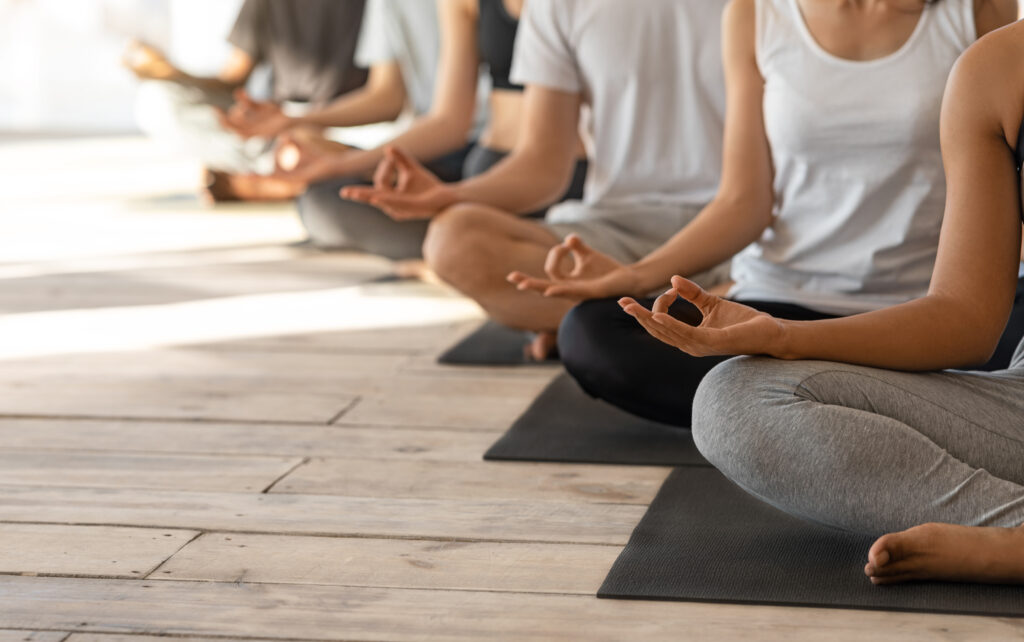
How is yoga different from other forms of movement and sport?
When people are not familiar to yoga, they often have the perception that it’s all about stretching. Or that they don’t know exactly what it is because they’ve never tried, but it’s not for them because it’s too soft. A client once told me that earlier on she had had the impression: “in yoga strange people are doing strange things” :). I still need to smile when I think of this. This client followed yoga therapy with me as part of her multidisciplinary burnout treatment, and by the end, she said that though she had been very sceptical initially, her perception completely changed and she wanted to continue with yoga classes close to her home. So what makes yoga unique?
Yoga is the discipline of inner connection: how do you feel in your body? What feelings and sensations do you notice while you are in the different yoga poses? Where do you feel a stretch, where do you need a stretch? Are you grounded or feel unstable…? How is your breath, while standing, sitting, in a twist or in an inversion? Where do you sense tension, and how can you release it? In the world of yoga (and neuroscience) this is called interoception, i.e. the capacity to feel the internal state of the body. Interoception is a skill, and like with any skill, some people have it more than others. I notice that people who have done sports, particularly since childhood, have a much more developed sense of their bodies and can express it also more clearly verbally. Others, particularly those with a complex trauma from childhood, have poor interoceptive skills. But good news, it’s a skill which can be practiced and learned by anyone, even if you start at a later age, though it takes time. Yoga is a wonderful way of developing the skill of interoception – simply because it is at its very core.
When you walk or run, you can still brood about loads of things, an unpleasant event that happened yesterday, a conversation that still needs to take place (and you design every single element of it in your mind), worry for a loved one, and so on. So, even though you did go for a walk or a run, your body and your mind were not aligned, and you might feel drained by the end. Focusing constantly on the future or on the past (this is what we do when we are brooding) is creating stress. Focusing on the here and now, and bringing our attention inward to the body is, on the other hand, deeply relaxing for the nervous system. Yoga does precisely this: brings your attention to the here and now, and to your body. No wonder quite many people can drift off into sleep at the end of a yoga session.
In other sports you also develop a sense of your body, in some more than others. I’d call dancing, gymnastics or martial arts highly interoceptive (you are very aware of your body and the subtleties of your movements), while in others the focus is more around performance (how to get further, faster…). So here the big difference: awareness vs performance. In yoga there is no such thing as performance: you don’t have to reach any particular target and you don’t have to compete or win, not even against yourself. You can of course become stronger, more flexible, or develop a better balance, but there is never a specific target to it – and if you have the idea that you should reach your toes, or you should be able to make a split, or that you should be able to do an arm balance, then you are moving away from the intent of yoga. That’s just not the point. If you do reach your toes and feel great while doing it, by all means do so, but it should not be a target or an expectation. The idea is rather to grow by finding your balance between “not too much” and “not too little” and to be fully present while doing so.
Yoga in its physical effects is really varied. It is perhaps most associated with stretching – and there certainly is quite a lot of stretching in there, for the whole body. It also includes the cardiac workout you would expect from active types of sport such as running – in a flowing practice such as vinyasa or a few sun salutations in a hatha class your heart will race and get toned. It also includes strength – core strength being the most important, i.e. strength of the innermost tummy and back muscles which give you stability while standing or sitting, but also strength of your legs, arms, back, neck… with a balanced practice, your whole body becomes stronger. It will also help you to improve your balance, partly thanks to a higher core strength, but also due to better focus. It is the combination of these different aspects in one practice which makes yoga unique: making your body stronger and flexible at the same time (think for a second about performance sports, which make your muscles stronger but shorter, so you need to do stretching afterwards), while also toning your heart, and improving your balance.
This said, by all means it’s a great thing to combine yoga with other forms of movement, performance sports such as running will have a higher cardiac impact, team sports (badminton, padel, football, etc) are amazing because you connect with other people, swimming has that fantastic meditative effect as you are all surrounded by water. Any movement is great for you, as long as you do it with care and attention for your body.
And one last thought on what makes yoga unique is its capacity to reduce stress. When you are suffering from long-term stress (and in our society, it’s hard to find someone who doesn’t), you will almost always find the advice to turn to yoga. If you have ever wondered why, I think the secret lies in the combination of all the above elements, i.e. that yoga is an essentially interoceptive practice, without performance targets, with a varied physical effect on the whole body, strengthening, lengthening, and balancing at the same time. It is a physical form of meditation, which allows you to drop your ego for a short while and just be, to experience your body while doing a practice which is fundamentally so healthy and rebalancing.

